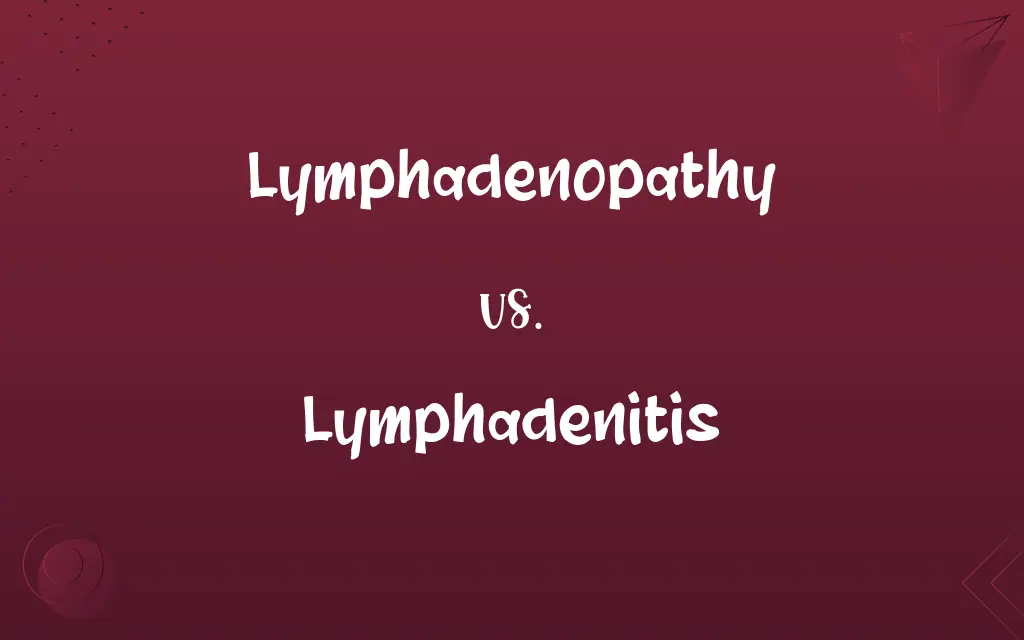Lymphadenopathy vs. Lymphadenitis: Know the Difference

By Shumaila Saeed & Hifza Nasir || Published on April 24, 2024
Lymphadenopathy refers to swollen or enlarged lymph nodes, often a sign of various conditions, not necessarily infections. Lymphadenitis specifically indicates inflammation of lymph nodes due to infection, a subset of lymphadenopathy.

Key Differences
Lymphadenopathy is a term that describes the condition of having enlarged lymph nodes, which can result from a wide range of causes, including infections, autoimmune diseases, and cancers. It's a general term that doesn't specify the underlying cause of the enlargement. Lymphadenitis, on the other hand, is a more specific condition where the lymph nodes become inflamed due to an infectious process, indicating a body's response to a bacterial, viral, or fungal infection.
Hifza Nasir
Apr 24, 2024
The presence of lymphadenopathy can signal various medical conditions, making it a critical symptom for doctors to investigate to determine the underlying cause. It can be localized, affecting lymph nodes in one area, or generalized, affecting multiple areas. Lymphadenitis is usually characterized by signs of infection such as redness, warmth, and tenderness over the affected lymph nodes, often accompanied by fever and other systemic symptoms of infection.
Shumaila Saeed
Apr 24, 2024
Diagnosis of lymphadenopathy involves medical history, physical examination, and possibly diagnostic tests such as blood tests, imaging, or biopsy to identify the cause. Lymphadenitis diagnosis focuses on identifying the infectious agent, using cultures or other microbiological tests, in addition to similar diagnostic steps taken for lymphadenopathy.
Shumaila Saeed
Apr 24, 2024
Treatment for lymphadenopathy varies widely depending on the underlying cause and might include observation, antibiotics for bacterial infections, or other specific therapies for conditions like cancer or autoimmune diseases. Lymphadenitis treatment typically involves antibiotics to target the infection causing the inflammation, along with supportive care to alleviate symptoms.
Dua Fatima
Apr 24, 2024
Understanding the difference between lymphadenopathy and lymphadenitis is crucial for proper diagnosis and treatment, reflecting the importance of identifying the cause of lymph node enlargement and targeting therapy accordingly.
Dua Fatima
Apr 24, 2024
ADVERTISEMENT
Comparison Chart
Definition
Swelling or enlargement of lymph nodes
Inflammation of lymph nodes due to infection
Shumaila Saeed
Apr 24, 2024
Causes
Infections, autoimmune diseases, cancers
Bacterial, viral, fungal infections
Hifza Nasir
Apr 24, 2024
Symptoms
Enlarged lymph nodes, possibly without pain
Tender, warm, swollen lymph nodes, often with fever
Shumaila Saeed
Apr 24, 2024
Diagnosis
Medical history, physical exam, possibly imaging or biopsy
Similar to lymphadenopathy, with focus on identifying infectious agents
Hifza Nasir
Apr 24, 2024
Treatment
Depends on underlying cause; varies widely
Primarily antibiotics for infection, plus supportive care
Hifza Nasir
Apr 24, 2024
ADVERTISEMENT
Lymphadenopathy and Lymphadenitis Definitions
Lymphadenopathy
Not always due to infection.
Lymphadenopathy in the armpit could be a sign of breast cancer.
Hifza Nasir
Feb 27, 2024
Lymphadenitis
Characterized by pain and tenderness.
Children with lymphadenitis often have tender, swollen nodes that are painful to touch.
Shumaila Saeed
Feb 27, 2024
Lymphadenopathy
Can be localized or generalized.
Swollen nodes in the neck due to a local infection indicate localized lymphadenopathy.
Shumaila Saeed
Feb 27, 2024
Lymphadenitis
Inflamed lymph nodes due to infection.
Streptococcal throat infection can cause cervical lymphadenitis.
Shumaila Saeed
Feb 27, 2024
Lymphadenopathy
Requires thorough investigation.
Persistent lymphadenopathy might prompt a biopsy to rule out lymphoma.
Shumaila Saeed
Feb 27, 2024
ADVERTISEMENT
Lymphadenitis
Accompanied by systemic symptoms.
Lymphadenitis from a cat scratch might include fever and fatigue.
Shumaila Saeed
Feb 27, 2024
Lymphadenopathy
Treatment varies by cause.
Antibiotics for bacterial infection or chemotherapy for cancer-related lymphadenopathy.
Hifza Nasir
Feb 27, 2024
Lymphadenitis
Treated with antibiotics.
Antibacterial therapy is used for bacterial lymphadenitis.
Hifza Nasir
Feb 27, 2024
Lymphadenopathy
General enlargement of lymph nodes.
An individual with HIV might develop generalized lymphadenopathy.
Hifza Nasir
Feb 27, 2024
Lymphadenitis
Diagnosed by identifying pathogens.
Culture tests can confirm the cause of lymphadenitis.
Hifza Nasir
Feb 27, 2024
Lymphadenopathy
An enlargement of the lymph nodes, usually associated with disease.
Shumaila Saeed
Jan 25, 2024
Lymphadenopathy
(medicine) An abnormal enlargement of the lymph nodes; it is often a nonspecific sign of infection but is also often of obscure origin and benign.
Shumaila Saeed
Jan 25, 2024
Lymphadenitis
Inflammation or swelling of lymph nodes; it is often a nonspecific sign of infection but is also often of obscure origin and benign.
Shumaila Saeed
Jan 25, 2024
Lymphadenitis
Inflammation of the lymphatic glands; - called also lymphitis.
Shumaila Saeed
Jan 25, 2024
Repeatedly Asked Queries
What is the main difference between lymphadenopathy and lymphadenitis?
Lymphadenopathy is the enlargement of lymph nodes for any reason, while lymphadenitis is specifically inflammation due to infection.
Hifza Nasir
Apr 24, 2024
Are there specific tests to diagnose lymphadenitis?
Diagnosis may involve microbiological tests to identify infectious agents, alongside other examinations used for lymphadenopathy.
Dua Fatima
Apr 24, 2024
Is lymphadenitis more serious than lymphadenopathy?
Lymphadenitis indicates an active infection, which may require prompt treatment, but the seriousness also depends on the underlying cause of lymphadenopathy.
Shumaila Saeed
Apr 24, 2024
How can doctors tell the difference between lymphadenopathy and lymphadenitis?
Through physical examination, patient history, and possibly diagnostic tests to identify signs of infection or other causes.
Dua Fatima
Apr 24, 2024
Can lymphadenopathy and lymphadenitis occur together?
Yes, lymphadenitis is a type of lymphadenopathy caused by infection, so they are related but not mutually exclusive.
Hifza Nasir
Apr 24, 2024
How long does lymphadenitis last?
The duration depends on the effectiveness of treatment and the body's response to the infection.
Shumaila Saeed
Apr 24, 2024
What are common locations for lymphadenopathy and lymphadenitis?
Common locations include the neck, armpits, and groin, where lymph nodes are more palpable.
Shumaila Saeed
Apr 24, 2024
Can lymphadenopathy turn into lymphadenitis?
Yes, if an underlying infection causes the lymph node enlargement, it can be classified as lymphadenitis.
Shumaila Saeed
Apr 24, 2024
Are swollen lymph nodes always a sign of infection?
No, swollen lymph nodes can result from a variety of causes, not just infections, including autoimmune diseases and cancers.
Dua Fatima
Apr 24, 2024
Is treatment for lymphadenopathy always necessary?
Treatment depends on the cause; some cases may resolve without specific therapy, while others require targeted treatment.
Hifza Nasir
Apr 24, 2024
What role do lymph nodes play in the body?
Lymph nodes are part of the immune system, helping to filter harmful substances and fight infections.
Hifza Nasir
Apr 24, 2024
Can lifestyle factors influence the risk of developing lymphadenopathy or lymphadenitis?
While lifestyle factors can influence overall health, the risk of these conditions primarily depends on exposure to pathogens, immune system health, and other individual health factors.
Shumaila Saeed
Apr 24, 2024
Why is it important to diagnose the cause of lymphadenopathy?
Identifying the cause is crucial for determining the appropriate treatment and addressing any underlying health issues.
Shumaila Saeed
Apr 24, 2024
Can both conditions affect children and adults alike?
Yes, both lymphadenopathy and lymphadenitis can occur in individuals of any age, depending on the underlying cause.
Hifza Nasir
Apr 24, 2024
What preventive measures can be taken against lymphadenitis?
Preventive measures include practicing good hygiene, staying up to date with vaccinations, and promptly treating infections.
Shumaila Saeed
Apr 24, 2024
Share this page
Link for your blog / website
HTML
Link to share via messenger
About Author
Written by
Shumaila SaeedShumaila Saeed, an expert content creator with 6 years of experience, specializes in distilling complex topics into easily digestible comparisons, shining a light on the nuances that both inform and educate readers with clarity and accuracy.
Co-written by
Hifza Nasir







































































